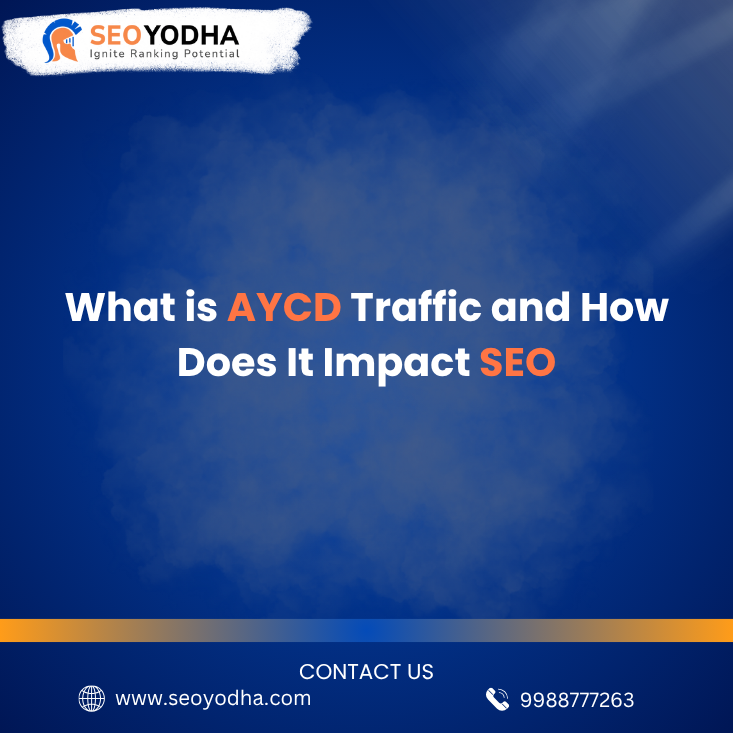SEO is all about organic growth, real user engagement, and long-term trust-building. But in the race to dominate search engine rankings, some website owners fall into the trap of using artificial means to boost performance—one of which includes AYCD traffic.
In this post, we’ll break down:
-
✅ What is AYCD Traffic?
-
✅ Why it’s being used
-
✅ The impact of AYCD traffic on your SEO strategy
-
✅ How Google responds to artificial traffic
-
✅ Safer, long-term alternatives for organic traffic growth
Let’s dive in.
💡 What is AYCD Traffic?
AYCD stands for “All You Can Do”, and AYCD Traffic refers to automated or artificially generated website visits using software, bots, or scripts to simulate user behavior.
The name “AYCD” comes from an automation suite (AYCD.io) primarily used by sneaker resellers and scalpers to mimic human activity online—such as solving captchas, running multiple browser sessions, and spoofing IP addresses to bypass detection.
🚨 How AYCD Traffic Works
AYCD tools can:
-
Send traffic to your website from multiple IPs
-
Randomize session duration and pages visited
-
Simulate click-throughs from search engines
-
Mask or rotate user agents and geolocations
The goal? To make traffic appear “organic” and trick platforms like Google, YouTube, or marketplaces into thinking your site is getting real user engagement.
Why Do Some Website Owners Use AYCD Traffic?
Website owners may be tempted to use AYCD traffic for several reasons:
-
To manipulate Google Analytics metrics (bounce rate, session duration)
-
To fake high CTRs from Google search results
-
To boost page views or ad impressions
-
To create “buzz” around a product launch or page
-
To influence rankings using artificial click-through rate (CTR) inflation
In theory, this sounds like a shortcut to growth. But in practice, AYCD traffic can be dangerous.
⚠️ How AYCD Traffic Impacts SEO (The Risks)
Let’s get one thing straight: AYCD traffic is not real traffic.
Google and other search engines are becoming more sophisticated in identifying fake signals, and abusing such tactics can lead to serious consequences.
1. Skewed Analytics
Using AYCD tools inflates your website traffic numbers, which may initially look good in your Google Analytics dashboard. But this fake data makes it impossible to measure actual user engagement, conversion rates, or bounce rates effectively.
2. No Real SEO Value
AYCD traffic does not result in backlinks, conversions, or content engagement. Google uses hundreds of signals—including time on site, scroll depth, interactions, and goal completions. Bots simply can’t replicate all that.
3. CTR Manipulation Backfires
While Google may consider CTR (Click Through Rate) as a ranking signal, manipulated CTR through AYCD bots is risky. If Google identifies unusual click behavior followed by short dwell time or immediate bounce, it may flag your website for manipulation.
4. Violation of Google Webmaster Guidelines
Google’s guidelines clearly state:
“Using automated programs or services to increase traffic to your site artificially is a violation and may result in a manual penalty or removal from search results.”
AYCD traffic is essentially black-hat SEO, and while it may offer a temporary spike, it’s not sustainable and may cause long-term harm.
5. Reputation and Trust Issues
If your hosting provider, ad network, or partners detect bot traffic, it can damage your brand’s trust and even lead to account suspension or removal from advertising programs.
Does AYCD Traffic Ever Help?
Only in isolated testing environments, like:
-
Server load testing
-
UI/UX simulation
-
Speed testing for high concurrent sessions
In real-world SEO and digital marketing, AYCD traffic has no real benefit and is not worth the risk.
SEO Yodha’s Take – What You Should Do Instead
At SEO Yodha, we always recommend playing the long game. SEO is not about gaming the system—it’s about building genuine authority, delivering value, and gaining trust from users and search engines alike.
Here’s what works:
🔍 1. Keyword Research with Buyer Intent
Target keywords with commercial or transactional value that align with your customer journey.
✍️ 2. Create High-Quality, Intent-Focused Content
Write for humans first, then optimize for Google. Include relevant FAQs, rich media, internal links, and engaging CTAs.
🔗 3. Earn Backlinks Naturally
Reach out to industry sites, publish guest posts, get mentioned on niche directories—white-hat link building works.
🚀 4. Optimize Your Website Performance
Use tools like Google PageSpeed Insights, Core Web Vitals, and Screaming Frog to ensure your technical SEO is in top shape.
🧭 5. Build Topical Authority
Publish content clusters and interlinked articles that dominate an entire subject space—this drives both traffic and trust.
🔚 Final Thoughts: AYCD Traffic vs Real SEO
Using AYCD traffic might give you a short-term high, but it’s like drinking saltwater—it looks like it helps, but ultimately hurts your SEO health.
If you’re serious about getting top rankings on Google, generating real leads, and building a respected brand, stay away from artificial traffic tools.
Instead, invest in transparent, ethical, and performance-driven SEO strategies that stand the test of time.
🙋♂️ Need Help with Your SEO?
At SEO Yodha, we specialize in creating custom SEO roadmaps that drive real traffic, improve rankings, and build long-term success. Whether you’re dealing with a traffic plateau or want to outrank your competitors with real results—we’ve got your back.
👉 Contact us today for a free consultation or check out our client success stories.
🔎 FAQs – AYCD Traffic & SEO
Q1: Is AYCD traffic legal?
AYCD traffic is not illegal, but it violates many platforms’ terms of service and Google’s webmaster guidelines.
Q2: Can AYCD traffic improve my rankings temporarily?
Maybe—but it’s highly risky and unsustainable. Once flagged, your rankings could drop dramatically.
Q3: How do I detect if my traffic is bot-driven?
Look for spikes in traffic from unusual countries, zero session duration, high bounce rates, or identical user agents in your logs.
Q4: What’s a safer way to increase traffic?
Focus on content marketing, backlink outreach, technical SEO, and local optimization.
Q5: Can you recover from a penalty caused by fake traffic?
Yes, but it requires a thorough cleanup, disavowal of bad links, and often a reconsideration request to Google.





